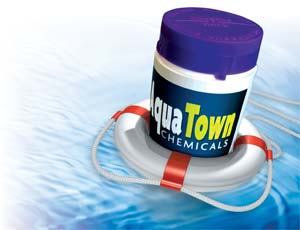MORE INFORMATION
- Market Forces
- Chemical Price Comparison
Chemical costs have risen significantly over the last year. Here is why.
How smaller stores compete with the big boxes on price.
Navigating the waters of chemical sales can be more hazardous than a leaky barrel of gas chlorine.
Look at the options: Lower retail prices to compete with Internet sellers, and margins could shrink to unmanageable levels. And on the other flank, big boxes always have the benefit of longer buys and purchasing in bulk. (To see a price comparison, click here.)
So how does a pool and/or spa supply store compete in a market that’s seen chemical prices rise by an estimated 30 percent in the last year?
First, it’s important to understand the competitive forces at work and the impact they have on profits. Next, we’ll delve into the differences geography makes in marketing, even for the same commodity. And finally, we’ll look at a few tips and words of advice from those in the know.
The opposition
Retailers face a number of threats to their profits from chemical sales. B&L Pools in Phoenix has seen chlorine prices climb 80 percent over the past three years.
Owner Dale Howard used to run a 40 percent mark-up on a 25-lb. bucket of chlorine, but it’s now less than half that, he says.
“Margins have really deteriorated,” Howard explains. “The big boxes are buying under contract, a year out or longer, so they’ll always have the advantage. Costco is now getting up toward a reasonable market cost, but Sam’s Club is only about 10 percent above wholesale prices.”
Just south of Sacramento in Elk Grove, Calif., All Clear Pool & Spa Supply has little choice but to keep chemical prices low, particularly on tablets, shock and liquid chlorine products. Assistant manager Jimmy Jordan says margins now hover between 10 and 20 percent.
This is necessary in an environment where selling against the Internet has become key to a retailer’s ability to survive.
“A lot of our customers shop online,” Jordan says, “and when they come into the store, they say we’re pretty competitive.”
The Internet has impacted pricing at WCI Pools and Spas’ two stores in Iowa as well. Chemical business remains strong, but it hasn’t been easy, reports owner Marshall Jurgens.
“We’ve tried not to make drastic changes…and we’re doing what we can to retain margins,” he says. “But we don’t radically mark up our chemicals either. Instead, we try to cushion it over several years.”
His manufacturer prices are up around 30 to 35 percent across the board, Jurgens says. And his customers may only see an increase on chlorine, for instance, from $25 to $35 over a 12-month period.
“The bottom line is we may have to absorb some of those costs,” he adds, “but hopefully it’ll settle down soon.”
Down South, Jack Willard contends with the big boxes as well. His main competitors are Sam’s Club and Lowe’s. But Willard also battles another foe.
“A lot of times we’re the same price or cheaper,” says the co-owner of Splash Pools & Spas in Daphne, Ala. “But the perception is big store, better price. And we’re a specialty store.
“We can educate the customers that come in,” he adds, “but it doesn’t really work to advertise [our prices] because they wouldn’t believe it. There’s not much we can do until we get them one-on-one.”
On average, Willard’s chlorine mark-ups only run 15 to 20 percent – the minimum needed to help cover overhead like rent, employees and equipment. Until this year, salt was a great seller for Willard and his wife Debbie, also co-owner. Margins typically ran 200 percent; now it’s about half that.
Top sellers
Much of the South has become a golfer’s paradise. Alabama alone is home to more than 250 public and private courses, and upkeep is an almost year-round endeavor.
An abundance of fertilizers and other compounds means algae often thrives across the region. As a result, phosphate removal systems have become reliable products for the Willards.
“We’re always looking at what levels those phosphates are at,” Jack says.
Climate is yet another factor. Much of Alabama has suffered drought-like conditions this summer. And every chemist knows that rainwater raises acidity. Calcium is a good stabilizer, but with less rain there’s less call for it.
Nearly 2,800 miles to the northwest, Orca Spa & Pool sales manager Jean McManigle caters to mostly (90 percent) hot tub owners. Among her leading chemicals — “our bread and butter,” she says — is bromine.
Along with being perceived as “more natural,” bromine also is an alkalinity increaser. And because the water in Seattle is largely acidic, hot tubs there can rust more easily. So owners are steered toward the product with an alkaline base.
Not far away in Elk Grove, Jordan says the high metallic content of municipal water can be problematic. He’s found a similar alternative to bromine in a pair of brand-name biguanides — Baquacil and BaquaSpa.
Still farther south, in Phoenix, trichlor tablets are standard fare, Howard says.
Lasting seven-to-eight times longer than some popular alternatives, trichlor offers greater protection from his region’s arid heat, he adds.
“We have good-sized business for liquid chlorine and cal hypo,” he says. “But the [trichlor] tablet really is our major price point chemical in this market.”
Lending support
Strong customer service — and the future business, referrals and goodwill it brings — has never been more important for traditional retailers.
McManigle at Orca has gotten creative with chlorine. At a 50 percent mark-up, it remains a good performer, she says.
So she’s begun buying in smaller volumes and marketing smaller quantities. It’s allowed her to sell more product — three of the 2-lb. variety vs. one 5-lb. container.
Other retailers may cross-promote chemicals with certain spa brands, or offer a discount with each pool opening.
Jack Willard, meantime, still must contend with his customers’ own preconceptions. A small percentage understands the difference between chemicals, he says, but for others, the explanation can be an exercise in futility.
“People may just buy chlorine because that’s all they’ve used for 100 years,” he says. “Nothing you can say is going to convince them otherwise. If the water’s clear, they’re good. That’s the mentality.”
Still, Willard tries to impress upon his bigger customers the importance of distinction.
“The ones we build for and do major repairs for, we make sure they know,” he says. “A big part of what we do is still educating the customers.”



